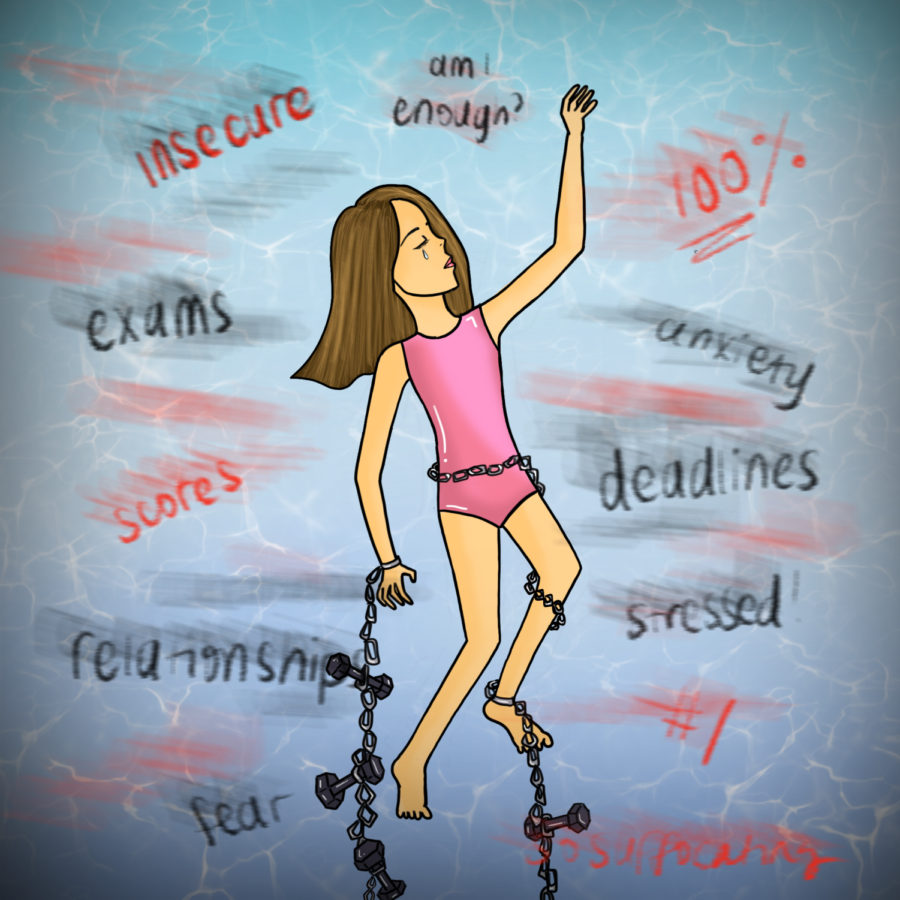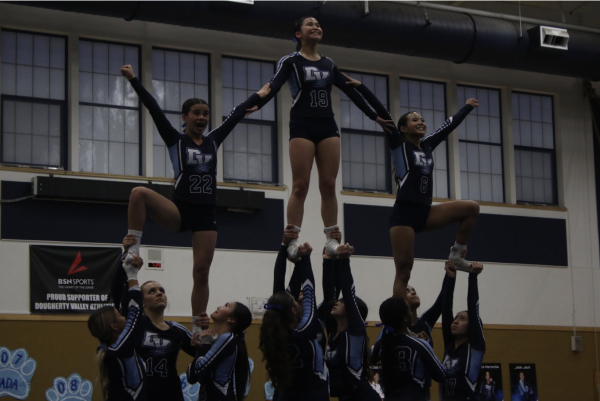Competitive sports can be detrimental to a student athlete’s mental health
Student athletes are afflicted with mental health issues such as anxiety and depression more commonly than non-athletes
February 10, 2022
“If you get tired, I don’t care.”
At my first swim practice on a new swim team, I vividly remember my coach reprimanding me and the other swimmers for performing poorly on a set. I was on the brink of tears because my arms felt like they were pulling through a pool full of jelly rather than water and I wished that my coach would understand. As I grew older, I observed my teammates becoming more anxious before meets and they often voiced their nervousness to me. I talked to my other friends who were cheerleaders, cross country runners and basketball players: they all reported that their mental health had been largely ignored by their coaches.
Student athletes in high school and college are more likely to struggle with mental health issues due to the pressure of being on a team. According to the Daily Northwestern, 55% of males reporting severe depression are athletes while 68% of females with depression are athletes. As mental health is stigmatized, especially among older coaches, it is important to acknowledge the topic. This should be the first step to amend this issue, followed by providing helpful and accessible mental health resources for athletes.
When I rejoined the swim team a few months ago after a year long hiatus due to COVID concerns, I stepped onto the pool deck with growing anxiety. The anxiety was tied to the feeling of frustration that came from failure at swim meets. To make matters worse, coaches were ignorant of my concerns and encouraged me to push my feelings down which led me to feel invisible to them. Swimming is an objective sport, and one’s success or failure is determined by hard, clear numbers. However, during the season, I would approach people in authority about these feelings, but I was told to “brush it off” and “just train better for the next swim meet.” For student athletes, there is a high pressure placed on their shoulders to outperform their teammates in order to preserve their career.
Although it may seem as if showing grit is a valuable quality in an athlete as it demonstrates “strength,” and being persistent shows that you are a “bad-ass,” athletes should be allowed to display weakness; they are human. My teammates (who were told similar things) and I agreed that we would benefit from being shown more empathy from our coaches.
According to the National Collegiate Athletic Association, “Anxiety disorders are among the most common psychiatric problems in student-athletes. Performance anxiety, panic disorder and phobic anxiety after an injury are more likely to be sports-related.”
Sports such as swimming, cross country and cheerleading rely on optimal performance to ensure an athlete’s advancement. For athletes, there are few opportunities to play the sport for a
profession. After all, there are only 53 Olympic swimmers. Other opportunities for swimmers include becoming a swim coach, or working for a swim related institution, but both of these careers typically pay less than six-figure salaries. The statistics are similar across the board for other sports. Furthermore, it only takes one torn muscle or one broken bone in order to erase a promising athlete’s future at the Olympics. For student athletes, there is a high pressure placed on their shoulders to outperform their teammates in order to preserve their career.
“Either you are a good cheerleader or you are not. I see other cheerleaders constantly comparing themselves to me, and then looking down upon themselves,” remarked M’Kai-Demi Sayyid, an all around cheerleader for Creekside Cheer and the Bay Semionels.
As an athlete, I spend $200 on swimsuits, goggles, caps and $1000 on team memberships annually. Every day, swim practice takes up over two hours of my day and weekend meets typically last four to six hours. I have cried on so many occasions that all the moments have blurred together. Being an athlete comes with an unsaid contract in which the sport requires the athlete to sacrifice a lot: their time, energy, passion, money and most importantly, their mental health.
“I had a lot of anxiety, and I was very depressed at some points too. But cheerleading was the one thing that was stable in my life and stunt was the one thing where I felt like I could grow from and genuinely see myself progress,” said Tiana Dey, the junior varsity cheer coach at Dougherty Valley High School.
Although sports is meant to be a difficult profession, there is a widespread stigma towards the discussion of mental health within the athletic community. The issue mainly arises with the coaches. Older generations of coaches did not experience the same stress when they were athletes that modern student athletes have to face.
“Mental health issues obviously have been exacerbated with the pandemic and have become more of an issue than 20 years ago when I was in high school and in college. When I was there, I didn’t really have those problems and people around me didn’t really have those problems,” mentioned varsity swim coach Ethan Schnell.
Decades ago, there was a different emphasis on academics and extracurriculars. Furthermore, the recent pandemic has worsened the issue of mental health for athletes as more stress has grown in other avenues of their lives, with few ways of receiving treatment through their sports programs.
“I think there should be some type of way that athletes can also talk about their mental health, if mental health is the issue. They need to put their mental health first,” said Dey.
Coaches, however, are not aware of how to approach mental health issues.
“There is no set-in-stone protocol that I am aware [of] that coaches are required to follow to help an athlete,” remarked Dey.
Furthermore, Schnell establishes clear, healthy boundaries in his relationships with his swimmers. “If my swimmer wants to have a chat, we sit down and get everything out. But then they have to get into the water and swim because they understand that my job is to be their coach,” reasoned Schnell.
There are ways to make amends to this stigma. Colleges across the country have sports psychologists available specifically for college athletes. According to the American Psychological Association, other professional organizations such as the Association for Applied Sport Psychology also have sports therapists available. Although it would help high school campuses, many public high schools lack the funds required to hire additional therapists where the need does not outweigh the cost. Other solutions are friendlier to the school’s wallet.
“Maybe they should have more training for coaches both on campus as well as [for] off campus coaches. At the least, they should be taught the signs and what to look for and what to listen for,” suggested Schnell.
Along with adequately trained coaches, sports programs in schools should make mental health a priority among athletes as rates of depression and anxiety among athletes steadily increase. Student athletes should be given access to better mental health resources in order for them to come to terms with their emotions in a healthy way. The issue of mental health should be talked more about within a team in order to get rid of the stigma behind it so that athletes can get the help they deserve.











